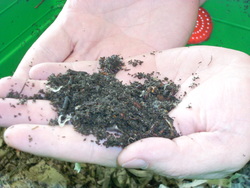Dinner with the worms
 |
Fort Worth, TX
5/6/2009
By Danielle Marshall, TCU Schieffer School of Journalism
Those who are hungry eat, and those who aren’t…give it to the worms. Wouldn’t it be a perfect world if any food we didn’t consume during a meal was reused? Welcome to the world of worm composting!
The process of vermicomposting, more commonly known as worm composting, has been around for more than 30 years. It is the process of recycling waste and leftover food by feeding it to worms living in a ventilated bin that is about the size of a recycling bin. The worms produce nutrient-rich castings (worm poop), which can be used as an organic fertilizer for your soil.
Dr. Mark Bloom, an assistant professor of science education at TCU, is one of many who can be credited for bringing this environmentally friendly process to educators in Fort Worth. With a compost bin in his kitchen and one in his office, he is very conscious of how much paper he throws away and the amount of waste he generates.
To spread the message, Dr. Bloom taught 30 Fort Worth ISD, White Settlement ISD, and TCU Starpoint School teachers about worm composting using a $2,000 TCU Green Grant. Additional funding and support came from TCU’s Andrews Institute of Mathematics, Science & Technology Education, the Fort Worth Botanic Gardens and the City of Fort Worth earlier this semester.
He gave teachers from various grade levels bins for their classrooms, so they could integrate the worm composting process with their current curriculum. Dr. Bloom hopes that creating awareness in teachers and encouraging them to write and teach about worm composting will cause a trickle-down effect. The goal is to generate students’ interest in worm composting, the worm life cycle and worm adaptation abilities.
As a Keep Fort Worth Beautiful board member, Dr. Bloom has learned that Fort Worth spends approximately $50 million a year on waste disposal. About 12.5 percent of the waste is food scraps (e.g., banana peels, vegetables, bread rinds, etc.). Once the scraps are thrown away, the waste goes into a landfill and produces methane gas, which is emitted into the atmosphere as a greenhouse gas.
According to Dr. Bloom, “Worm composting can reduce the amount of waste produced and create renewable resources to use in and around homes.”
Sterilized bins, which are available at home and garden centers, may be used as effective composters only after ventilation holes are created to aid in breathing. Next, add worm bedding (shredded newspaper or dried leaves), water, some coffee grounds (which help break down the worms’ food) and about a half pound of special worms called “red wigglers”.
Red wigglers, which can be purchased from the Web site www.catchtherain.com, are ideal because they are moisture-sensitive, surface-dwelling worms that breathe through their skin. They are used to breaking down leaves and ground materials, and are not easily agitated if their habitat is disturbed unlike night crawlers or earthworms, who prefer not to be bothered since they burrow themselves under the surface.
Once the essential components have been assembled, food scraps are added and the worms go to work, eating the non-meat and bone food waste along with the easily digestible newspaper. It is common to use a daily worm-to-garbage ratio of 2:1 pounds. A remarkable element of the process is that food does not rot because the worms start eating it almost immediately, although it may sometimes take up to seven days for the food to completely disappear.
Worm castings are identical to soil, so they can be used in that capacity as well as a soil fertilizer. Maintaining and monitoring the worm bins are essential to prevent excess food, paper or water from accumulating. Any excess can inhibit air exchange, challenge the worm’s ability to move or even suffocate them.
Visit here to learn more learn about worm composting and Dr. Bloom’s work with teachers.










